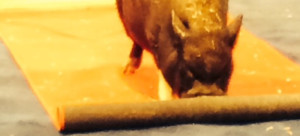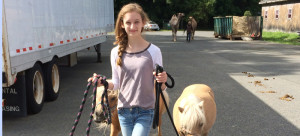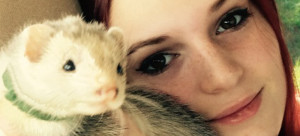Spotlights gleamed around the ring. People cheered as the show opened with bursts of trumpets and pounding drums. Newman, a long-time circus pig, unrolled the red carpet for the show to begin. Little did he know that his show days were coming to an end. From New York, the Big Apple, to forested areas of North Carolina, New- man will become a pet.
Newman is a retiring circus pig who will be living with freshman Skyler Herrick and her family. Having a father as a part-time circus musician allowed Herrick to negotiate for ownership of Newman.

“We lived in a trailer for a while back in New York,” Herrick said. “[We] usually helped care for the animals and Newman was one of them. We heard of his retirement from the circus and we thought ‘Why not get him?’”
Pets are animals that physically and emotionally help others through the love they spread. They build companionship and support for all diverse individuals, young or old. The most popular pets are the classic cat or dog, but Northwood has students and teachers that care for unique companions.
Some students, like Tristan Cochran, have pets that live on a farm. Livestock, like cows, are not considered pets, but Cochran had a companion that was more than part of the farm.
When Cochran was younger, he was given a duckling to care for on his farmhouse. The duck, Jared, was Cochran’s pet for four years. Spending time outside with Jared was Cochran’s favorite pastime. He would go on walks with Jared following him.
“She would take walks through the woods and fields with me because I would get bored,” Cochran said. “I lived on a farm and we didn’t have much technology, so I spent most of my time outside.”
Cochran shared stories about the winters and outdoor walks he shared with Jared. The duck was much like a “dog,” according to Cochran.

“They’re actually incredibly loyal,” Cochran said. “It would follow me around everywhere. Wherever I was, that duck was there.”
Ducks and pigs are not every student’s first pet choice. Many kids may get simple pets such as fish. Science teacher Phillip Cox owned a small stingray as a class pet. Over 20 years ago, he received a stingray from the now-closed Raleigh Coastal Celebration, an event where fishers displayed creatures of the sea.
“[The stingray] just happened,” Cox said. ”The people from the coast brought it up and thought it would be better to give it to me. I would bring my bucket with me at dawn to collect the fish.”
The stingray was a part of the class aquarium Cox had in his previous years. He cared for several other kinds of unique fish throughout his life.
“I enjoy [fish],” Cox said. “They were fun and I just love them. Fish are so cool because it’s just their own little world that you can stick them in.”
Cox says that after having fish for several years, he would release them back into the ocean.
“With a ray, you can take it back down to the coast, toss him in. Everything’s cool,” Cox said. “If you have a tiger, you can’t just toss him. A lot of people don’t do the background research on their pets. Then they’re stuck. Depending on the pet, you really have to think twice.”
Some pet owners don’t have proper knowledge of the pets they live with, but senior Kierra Robertson understands the vicious little creatures that she and her father care for. Robertson has a hamster-like animal called a vole that she named Reaver. Though Riever is a part of her father’s scientific research on voles, she cares for Reaver as her own pet. Robertson has to take some extra precautions when handling her feisty pet.
“She bites,” Robertson said. “Every time I open her cage I have to wear a sock [on my hand].”

Though voles are small rodents, domestication is not part of their natural cycle. Voles are known to attack the roots of trees and small plants, making them detrimental to the environment.
“They’re just like hamsters, but they probably shouldn’t [become pets],” Robertson said. “I have them because of my dad’s research, but they shouldn’t be raised as pets.”
Though voles aren’t compatible domestic pets, ferrets are close relatives that are well trained for households. Freshman Lindy McDonnell had a white-headed male ferret named Ana, which McDonnell said was “crazy.” She would leash Ana and give him regular walks around her neighborhood, much like a dog.
“They are awesome and fun and they always want to play,” McDonnell said.
Ferrets are only a small portion of the diverse pets that could become a long lasting friend. Whatever form or kind of animal a pet is, the love and experiences shared with them are universal.
“If you have the space, why not get [a pet]?” Herrick said. “I’ll probably have more work to do [with Newman], but it shouldn’t be too bad.”
– By Betty Her
